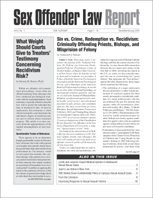Ironies Involving Actuarial Risk Instrumentation Use in Civil Commitment Assessments
Author: Dennis M. Doren, Ph.D., DABPS, ABAP.
Source: Volume 02, Number 03, April/May 2001 , pp.35-36(2)

< previous article |next article > |return to table of contents
Abstract:
Within the United States, there are currently 15 states with actively implemented sex offender civil commitment laws. A vast majority of examiners doing these evaluations employ one or more actuarial instruments when doing the relevant risk assessment. (D.M. Doren, “Performing and Testifying About Sex Offender Risk Assessments for Civil Commitment Purposes,” presented at the 18th Annual Research and Treatment Conference of the Assoc. for the Treatment of Sexual Abusers (Sept. 1999).) Scales such as the Rapid Risk Assessment for Sex Offense Recidivism (RRASOR); the Minnesota Sex Offender Screening Tool—Revised (MnSOST-R); and the Static- 99 have become mainstays in evaluators’ arsenals. (R.K. Hanson, “The Development of a Brief Actuarial Risk Scale for Sexual Offense Recidivism,” Ministry of the Solicitor General of Canada (1997); D.L. Epperson, J.D. Kaul, and D. Hesselton, “Final Report on the Development of the Minnesota Sex Offender Screening Tool— Revised,” presented at the 17th Annual Research & Treatment Conf. of the Assoc. for the Treatment of Sexual Abusers (Oct. 1998); R.K. Hanson and D. Thornton, “Improving Risk Assessments for Sex Offenders: A Comparison of Three Actuarial Scales,” 24 (1) L. & Hu. Beh. 119 (2000).) In effect, the employment of actuarial risk assessment scales has effectively become one aspect of the professional standards by which civil commitment evaluations are conducted.Keywords:
Affiliations:
1: Mendota Mental Health Institute.